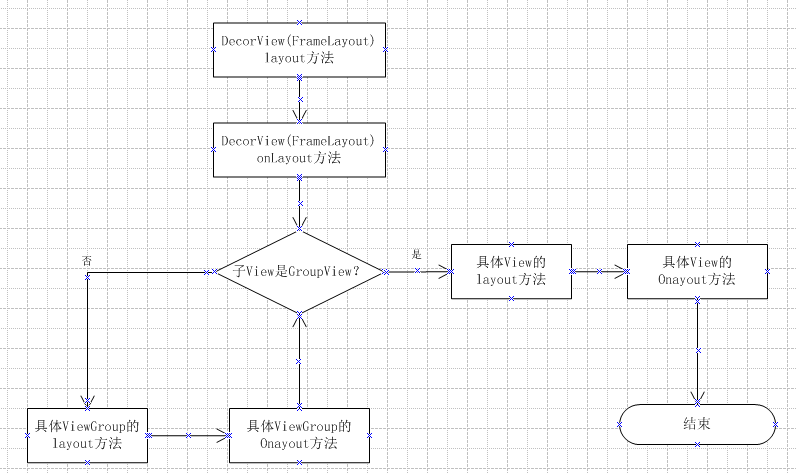在清楚了View绘制机制中的第一步测量之后,我们继续来了解分析View绘制的第二个过程,那就是布局定位。继续跟踪分析源码,根据之前的流程分析我们知道View的绘制是从RootViewImpl的performTraversals方法开始的,在此方法中依次调用了performMeasure、performLayout、performDraw等方法进行测量、布局、绘制,那么下面我们就看看则方performLayout中都做了哪些事情,该方法的关键源码如下:
private void performLayout(WindowManager.LayoutParams lp, int desiredWindowWidth, int desiredWindowHeight) { mLayoutRequested = false; mScrollMayChange = true; mInLayout = true; final View host = mView; …… try { host.layout(0, 0, host.getMeasuredWidth(), host.getMeasuredHeight()); …… } finally { Trace.traceEnd(Trace.TRACE_TAG_VIEW); } mInLayout = false; }
从中看出,最关键的代码就是调用了host.layout方法,那么大家还记不记得host是个什么东东呢?对了,正是我们之前说的根视图DecorView。那么我们就回到DecorView看看它在layout方法中到底做了什么事情。令人失望的是,我们在DecorView中并没有发现该方法,不要急,根据该类的继承体系,我们最终追踪到layout方法在View中。

public void layout(int l, int t, int r, int b) { if ((mPrivateFlags3 & PFLAG3_MEASURE_NEEDED_BEFORE_LAYOUT) != 0) { onMeasure(mOldWidthMeasureSpec, mOldHeightMeasureSpec); mPrivateFlags3 &= ~PFLAG3_MEASURE_NEEDED_BEFORE_LAYOUT; } int oldL = mLeft; int oldT = mTop; int oldB = mBottom; int oldR = mRight; boolean changed = isLayoutModeOptical(mParent) ? setOpticalFrame(l, t, r, b) : setFrame(l, t, r, b); if (changed || (mPrivateFlags & PFLAG_LAYOUT_REQUIRED) == PFLAG_LAYOUT_REQUIRED) { onLayout(changed, l, t, r, b); mPrivateFlags &= ~PFLAG_LAYOUT_REQUIRED; ListenerInfo li = mListenerInfo; if (li != null && li.mOnLayoutChangeListeners != null) { ArrayList<OnLayoutChangeListener> listenersCopy = (ArrayList<OnLayoutChangeListener>)li.mOnLayoutChangeListeners.clone(); int numListeners = listenersCopy.size(); for (int i = 0; i < numListeners; ++i) { listenersCopy.get(i).onLayoutChange(this, l, t, r, b, oldL, oldT, oldR, oldB); } } } mPrivateFlags &= ~PFLAG_FORCE_LAYOUT; mPrivateFlags3 |= PFLAG3_IS_LAID_OUT; } protected void onLayout(boolean changed, int left, int top, int right, int bottom) {}
该方法中的4个参数代表了当前的View与父View之间4个方向上的距离,同时从说明中可以看出,此方法不应该被子类重写,如果需要重新布局,可以在子类中重写的方法是onLayout,此方法在View中是个空方法,什么都没有写。可实际上layout的方法在View中并没有被标识为final,这就意味是可以被重写的。
继续查看ViewGoup中的相关代码,果然layout被重写了并添加了final标识,同时onLayout被标识为抽象方法,所以继承了ViewGroup的类是,是不能重写layout方法的,并且要实现onLayout方法。从代码可以看出,虽然ViewGroup重写了layout,实际本质上还是调用了View的layout,然后通过调用onLayout方法最终完成布局定位的。
@Override public final void layout(int l, int t, int r, int b) { if (!mSuppressLayout && (mTransition == null || !mTransition.isChangingLayout())) { if (mTransition != null) { mTransition.layoutChange(this); } super.layout(l, t, r, b); } else { // record the fact that we noop'd it; request layout when transition finishes mLayoutCalledWhileSuppressed = true; } } @Override protected abstract void onLayout(boolean changed, int l, int t, int r, int b);
在DecorView中,并没有发现onLayout方法,所以它使用的肯定是其父类FrameLayout中的,找到FrameLayout的源码,可以查看到onLayout方法,具体如下:
@Override protected void onLayout(boolean changed, int left, int top, int right, int bottom) { layoutChildren(left, top, right, bottom, false /* no force left gravity */); } void layoutChildren(int left, int top, int right, int bottom, boolean forceLeftGravity) { final int count = getChildCount(); final int parentLeft = getPaddingLeftWithForeground(); final int parentRight = right - left - getPaddingRightWithForeground(); final int parentTop = getPaddingTopWithForeground(); final int parentBottom = bottom - top - getPaddingBottomWithForeground(); mForegroundBoundsChanged = true; for (int i = 0; i < count; i++) { final View child = getChildAt(i); if (child.getVisibility() != GONE) { final LayoutParams lp = (LayoutParams) child.getLayoutParams(); final int width = child.getMeasuredWidth(); final int height = child.getMeasuredHeight(); int childLeft; int childTop; int gravity = lp.gravity; if (gravity == -1) { gravity = DEFAULT_CHILD_GRAVITY; } final int layoutDirection = getLayoutDirection(); final int absoluteGravity = Gravity.getAbsoluteGravity(gravity, layoutDirection); final int verticalGravity = gravity & Gravity.VERTICAL_GRAVITY_MASK; switch (absoluteGravity & Gravity.HORIZONTAL_GRAVITY_MASK) { case Gravity.CENTER_HORIZONTAL: childLeft = parentLeft + (parentRight - parentLeft - width) / 2 + lp.leftMargin - lp.rightMargin; break; case Gravity.RIGHT: if (!forceLeftGravity) { childLeft = parentRight - width - lp.rightMargin; break; } case Gravity.LEFT: default: childLeft = parentLeft + lp.leftMargin; } switch (verticalGravity) { case Gravity.TOP: childTop = parentTop + lp.topMargin; break; case Gravity.CENTER_VERTICAL: childTop = parentTop + (parentBottom - parentTop - height) / 2 + lp.topMargin - lp.bottomMargin; break; case Gravity.BOTTOM: childTop = parentBottom - height - lp.bottomMargin; break; default: childTop = parentTop + lp.topMargin; } child.layout(childLeft, childTop, childLeft + width, childTop + height); } } }
从方法中,我们可以看出在Framelayout中最终调用了layoutChildren方法,在该方法中根据测量结果和一些布局属性对容器中每一个View都调用了layout方法进行了布局。根据以上的代码分析,我们可以得出View布局定位的流程图如下。

疑问咨询或技术交流,请加入官方QQ群: (452379712)
(452379712)
出处:http://www.cnblogs.com/jerehedu/
本文版权归烟台杰瑞教育科技有限公司和博客园共有,欢迎转载,但未经作者同意必须保留此段声明,且在文章页面明显位置给出原文连接,否则保留追究法律责任的权利。